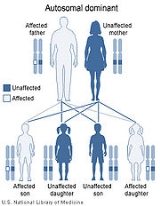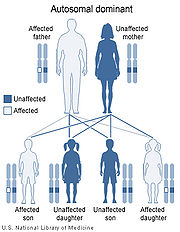
Spondyloepimetaphyseal dysplasia, Strudwick type
Encyclopedia
Spondyloepimetaphyseal dysplasia, Strudwick type is an inherited disorder of bone
growth that results in dwarfism
, characteristic skeletal abnormalities, and problems with vision
. The name of the condition indicates that it affects the bones of the spine
(spondylo-) and two regions near the ends of bones (epiphyses and metaphyses). This type was named after the first reported patient with the disorder. Spondyloepimetaphyseal dysplasia, Strudwick type is a subtype of collagenopathy, types II and XI
.
The signs and symptoms of this condition at birth are very similar to those of spondyloepiphyseal dysplasia congenita
, a related skeletal disorder. Beginning in childhood, the two conditions can be distinguished in X-ray
images by changes in areas near the ends of bones (metaphyses). These changes are characteristic of spondyloepimetaphyseal dysplasia, Strudwick type.
People with this condition are short-statured from birth, with a very short trunk and shortened limbs. Their hands and feet, however, are usually average-sized. Curvature of the spine (scoliosis
and lumbar lordosis) may be severe and can cause problems with breathing. Changes in the spinal bones (vertebrae) in the neck may also increase the risk of spinal cord
damage. Other skeletal signs include flattened vertebrae (platyspondyly), severe protrusion of the breastbone (pectus carinatum
), a hip joint deformity in which the upper leg bones turn inward (coxa vara
), and a foot deformity known as clubfoot.
Affected individuals have mild and variable changes in their facial features. The cheekbones close to the nose may appear flattened. Some infants are born with an opening in the roof of the mouth, which is called a cleft palate. Severe nearsightedness (high myopia
) and detachment of the retina
(the part of the eye that detects light and color) are also common.
 This condition is one of a spectrum of skeletal disorders caused by mutations in the COL2A1
This condition is one of a spectrum of skeletal disorders caused by mutations in the COL2A1
gene. The protein made by this gene forms type II collagen
, a molecule found mostly in cartilage
and in the clear gel that fills the eyeball (the vitreous
). Type II collagen is essential for the normal development of bones and other connective tissue
s. Mutations in the COL2A1 gene interfere with the assembly of type II collagen molecules, which prevents bones from developing properly and causes the signs and symptoms of this condition.
This condition is inherited in an autosomal dominant pattern, which means one copy of the altered gene is sufficient to cause the disorder.
Bone
Bones are rigid organs that constitute part of the endoskeleton of vertebrates. They support, and protect the various organs of the body, produce red and white blood cells and store minerals. Bone tissue is a type of dense connective tissue...
growth that results in dwarfism
Dwarfism
Dwarfism is short stature resulting from a medical condition. It is sometimes defined as an adult height of less than 4 feet 10 inches , although this definition is problematic because short stature in itself is not a disorder....
, characteristic skeletal abnormalities, and problems with vision
Visual perception
Visual perception is the ability to interpret information and surroundings from the effects of visible light reaching the eye. The resulting perception is also known as eyesight, sight, or vision...
. The name of the condition indicates that it affects the bones of the spine
Vertebral column
In human anatomy, the vertebral column is a column usually consisting of 24 articulating vertebrae, and 9 fused vertebrae in the sacrum and the coccyx. It is situated in the dorsal aspect of the torso, separated by intervertebral discs...
(spondylo-) and two regions near the ends of bones (epiphyses and metaphyses). This type was named after the first reported patient with the disorder. Spondyloepimetaphyseal dysplasia, Strudwick type is a subtype of collagenopathy, types II and XI
Collagenopathy, types II and XI
The type II and XI collagenopathies are a group of disorders that affect connective tissue, the tissue that supports the body's joints and organs. These disorders are caused by defects in type II or type XI collagen. Collagens are complex molecules that provide structure, strength, and elasticity ...
.
The signs and symptoms of this condition at birth are very similar to those of spondyloepiphyseal dysplasia congenita
Spondyloepiphyseal dysplasia congenita
Spondyloepiphyseal dysplasia congenita is a rare disorder of bone growth that results in dwarfism, characteristic skeletal abnormalities, and occasionally problems with vision and hearing...
, a related skeletal disorder. Beginning in childhood, the two conditions can be distinguished in X-ray
X-ray
X-radiation is a form of electromagnetic radiation. X-rays have a wavelength in the range of 0.01 to 10 nanometers, corresponding to frequencies in the range 30 petahertz to 30 exahertz and energies in the range 120 eV to 120 keV. They are shorter in wavelength than UV rays and longer than gamma...
images by changes in areas near the ends of bones (metaphyses). These changes are characteristic of spondyloepimetaphyseal dysplasia, Strudwick type.
People with this condition are short-statured from birth, with a very short trunk and shortened limbs. Their hands and feet, however, are usually average-sized. Curvature of the spine (scoliosis
Scoliosis
Scoliosis is a medical condition in which a person's spine is curved from side to side. Although it is a complex three-dimensional deformity, on an X-ray, viewed from the rear, the spine of an individual with scoliosis may look more like an "S" or a "C" than a straight line...
and lumbar lordosis) may be severe and can cause problems with breathing. Changes in the spinal bones (vertebrae) in the neck may also increase the risk of spinal cord
Spinal cord
The spinal cord is a long, thin, tubular bundle of nervous tissue and support cells that extends from the brain . The brain and spinal cord together make up the central nervous system...
damage. Other skeletal signs include flattened vertebrae (platyspondyly), severe protrusion of the breastbone (pectus carinatum
Pectus carinatum
Pectus carinatum, , also called pigeon chest, is a deformity of the chest characterized by a protrusion of the sternum and ribs. It is the opposite of pectus excavatum.-Causes:...
), a hip joint deformity in which the upper leg bones turn inward (coxa vara
Coxa vara
Coxa vara is a deformity of the hip, whereby the angle between the ball and the shaft of the femur is reduced to less than 120 degrees. This results in the leg being shortened, and therefore a limp occurs. It is commonly caused by injury, such as a fracture...
), and a foot deformity known as clubfoot.
Affected individuals have mild and variable changes in their facial features. The cheekbones close to the nose may appear flattened. Some infants are born with an opening in the roof of the mouth, which is called a cleft palate. Severe nearsightedness (high myopia
Myopia
Myopia , "shortsightedness" ) is a refractive defect of the eye in which collimated light produces image focus in front of the retina under conditions of accommodation. In simpler terms, myopia is a condition of the eye where the light that comes in does not directly focus on the retina but in...
) and detachment of the retina
Retina
The vertebrate retina is a light-sensitive tissue lining the inner surface of the eye. The optics of the eye create an image of the visual world on the retina, which serves much the same function as the film in a camera. Light striking the retina initiates a cascade of chemical and electrical...
(the part of the eye that detects light and color) are also common.

COL2A1
Collagen, type II, alpha 1 , also known as COL2A1, is a human gene that provides instructions for the production of the pro-alpha1 chain of type II collagen....
gene. The protein made by this gene forms type II collagen
Collagen
Collagen is a group of naturally occurring proteins found in animals, especially in the flesh and connective tissues of mammals. It is the main component of connective tissue, and is the most abundant protein in mammals, making up about 25% to 35% of the whole-body protein content...
, a molecule found mostly in cartilage
Cartilage
Cartilage is a flexible connective tissue found in many areas in the bodies of humans and other animals, including the joints between bones, the rib cage, the ear, the nose, the elbow, the knee, the ankle, the bronchial tubes and the intervertebral discs...
and in the clear gel that fills the eyeball (the vitreous
Vitreous humour
The vitreous humour or vitreous humor is the clear gel that fills the space between the lens and the retina of the eyeball of humans and other vertebrates...
). Type II collagen is essential for the normal development of bones and other connective tissue
Connective tissue
"Connective tissue" is a fibrous tissue. It is one of the four traditional classes of tissues . Connective Tissue is found throughout the body.In fact the whole framework of the skeleton and the different specialized connective tissues from the crown of the head to the toes determine the form of...
s. Mutations in the COL2A1 gene interfere with the assembly of type II collagen molecules, which prevents bones from developing properly and causes the signs and symptoms of this condition.
This condition is inherited in an autosomal dominant pattern, which means one copy of the altered gene is sufficient to cause the disorder.

